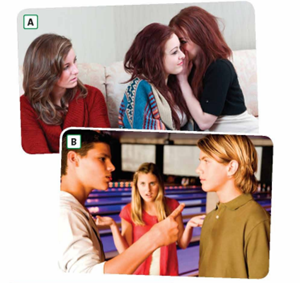Tiếng Anh 12 Unit 1 1G. Speaking
1 SPEAKING Work in pairs. Think of three things that might cause friends to fall out. 2 KEY PHRASES Read the Speaking Strategy and complete the phrases with the words below.3 SPEAKING Work in pairs. Describe photos A and B. Use phrases from exercise 2 to speculate about the people.
Tổng hợp đề thi học kì 1 lớp 12 tất cả các môn - Chân trời sáng tạo
Toán - Văn - Anh - Lí - Hóa - Sinh - Sử - Địa
Bài 1
1 SPEAKING Work in pairs. Think of three things that might cause friends to fall out.
(Làm việc theo cặp. Hãy nghĩ đến ba điều có thể khiến bạn bè bất hòa.)
Lời giải chi tiết:
Three things that might cause friends to fall out are: miscommunication, betrayal of trust and divergence in values or priorities.
(Ba điều có thể khiến bạn bè rạn nứt là: giao tiếp sai lạc, phản bội lòng tin và sự khác biệt về giá trị hoặc ưu tiên)
Bài 2
2 KEY PHRASES Read the Speaking Strategy and complete the phrases with the words below.
(Đọc Chiến lược Nói và hoàn thành các cụm từ với các từ bên dưới.)

Speculating and deducing
1 He's yawning, so he __________ be tired or bored.
2 She's laughing, so she __________ be sad.
3 He may/might/could __________ lonely.
4 It looks __________ if…
5 The photo __________ to show (a living room).
6 She looks __________ a (nice person).
7 Judging by (their expressions), I'd __________ that…
8 I can't be __________, but…
9 I might be __________, but…
10 The boy __________ be (accusing him of something).
Phương pháp giải:
Speaking Strategy
When you talk about photos, say what you can guess or deduce as well as about what you can see. Use modal verbs of deduction and phrases such as it appears to show..., I can't be certain, but..., etc.
(Khi bạn nói về những bức ảnh, hãy nói những gì bạn có thể đoán hoặc suy luận cũng như những gì bạn có thể nhìn thấy. Sử dụng các động từ khiếm khuyết và các cụm từ như nó thể hiện..., tôi không thể chắc chắn, nhưng..., v.v.)
Lời giải chi tiết:
Speculating and deducing (Suy đoán và suy luận)
1 He's yawning, so he must be tired or bored.
(Anh ấy đang ngáp, chắc là anh ấy mệt hoặc buồn chán.)
2 She's laughing, so she can't be sad.
(Cô ấy cười nên không buồn được.)
3 He may/might/could be lonely.
(Anh ấy có thể cô đơn.)
4 It looks as if…
(Có vẻ như…)
5 The photo appears to show (a living room).
(Bức ảnh dường như hiển thị (một phòng khách).)
6 She looks like a (nice person).
(Cô ấy trông giống như một (người tốt).)
7 Judging by (their expressions), I'd say that…
(Xét theo (biểu hiện của họ), tôi có thể nói rằng…)
8 I can't be certain, but…
(Tôi không thể chắc chắn, nhưng…)
9 I might be wrong, but…
(Có thể tôi sai, nhưng…)
10 The boy seems to be (accusing him of something).
(Cậu bé dường như đang (buộc tội cậu ta về điều gì đó).)
Bài 3
3 SPEAKING Work in pairs. Describe photos A and B. Use phrases from exercise 2 to speculate about the people.
(Làm việc theo cặp. Miêu tả bức ảnh A và B. Sử dụng các cụm từ ở bài tập 2 để suy đoán về những người.)

Judging by her expression, I’d…(Đánh giá qua biểu hiện của cô ấy, tôi sẽ…)
Lời giải chi tiết:
- There are 3 women in the picture A. Two of them are whispering to each other, while the third one appears curious or nosy. It seems like the two women whispering might be sharing a secret. The third woman looks like she's trying to figure out what they are talking about.
(Có 3 người phụ nữ trong hình A. Hai người trong số họ đang thì thầm với nhau, trong khi người thứ ba tỏ ra tò mò hoặc tọc mạch. Có vẻ như hai người phụ nữ đang thì thầm với nhau có thể đang chia sẻ một bí mật. Người phụ nữ thứ ba có vẻ như đang cố gắng hiểu họ đang nói về điều gì.)
- There are two boys in the photo who seem to be arguing, making eye contact. There's a girl in the middle who appears unsure about what to do. The boys might be having a disagreement or argument. The girl in the middle seems uncertain, as if she doesn't know how to handle the situation.
(Trong ảnh có hai chàng trai đang tranh cãi, giao tiếp bằng mắt. Có một cô gái ở giữa tỏ ra không biết phải làm gì. Các chàng trai có thể đang có bất đồng hoặc tranh cãi. Cô gái ở giữa có vẻ không chắc chắn, như thể cô ấy không biết phải xử lý tình huống này như thế nào.)
Bài 4
4 Read the Learn this! box. Make up two more sentences about your photo in exercise 3 beginning with must have, might have or can't have.
(Hãy học khung Learn this! Viết thêm hai câu về bức ảnh của bạn trong bài tập 3 bắt đầu bằng must have, might have hoặc can't have.)
Phương pháp giải:
LEARN THIS! might / must / can't have
We use might have + past participle to speculate about past events. We use must have / can't have + past participle to make deductions about past events and say what is or is not possible.
They might have been good friends once - I don't know.
I haven't got my phone. I must have left it at home.
She can't have gone home. Her coat is still on the chair.
Tạm dịch:
LEARN THIS! có thể / phải / không thể có
Chúng ta sử dụng might Have + quá khứ phân từ để suy đoán về các sự kiện trong quá khứ. Chúng ta sử dụng must have / can't have + quá khứ phân từ để suy luận về các sự kiện trong quá khứ và nói điều gì có thể hoặc không thể.
Họ có thể đã từng là bạn tốt - tôi không biết.
Tôi không có điện thoại. Chắc là tôi đã để nó ở nhà.
Cô ấy không thể về nhà được. Áo khoác của cô ấy vẫn còn trên ghế.
Lời giải chi tiết:
Picture A: Observing the expressions, the woman on the right must have shared a surprising piece of news with the other two, explaining their hushed conversation.
(Hình A: Quan sát biểu cảm, người phụ nữ bên phải chắc hẳn đã chia sẻ một tin tức đáng ngạc nhiên với hai người kia, giải thích cho cuộc trò chuyện im lặng của họ.)
Picture B: Considering the intensity of their gazes, the two boys can't have resolved their disagreement yet, leaving the girl in the middle in a state of unease.
(Hình B: Xét về ánh mắt, hai chàng trai vẫn chưa giải quyết được mâu thuẫn, khiến cô gái ở giữa rơi vào tâm trạng bất an.)
Bài 5
5 Listen to a student doing the task below using the photos in exercise 3. Answer the questions below.
(Nghe một học sinh thực hiện nhiệm vụ dưới đây bằng cách sử dụng các bức ảnh ở bài tập 3. Trả lời các câu hỏi bên dưới.)
Compare the photos. Then give your own opinion about whether arguments always damage friendships or sometimes make them stronger.
(So sánh các bức ảnh. Sau đó đưa ra quan điểm của riêng bạn về việc liệu những cuộc tranh cãi luôn làm tổn hại đến tình bạn hay đôi khi khiến chúng trở nên bền chặt hơn.)
1 Are his speculations about the photos similar to yours?
(Suy đoán của anh ấy về những bức ảnh có giống với suy đoán của bạn không?)
2 What phrases from exercise 2 does he use?
(Anh ấy sử dụng những cụm từ nào trong bài tập 2?)
3 What is his overall opinion about friendships and arguments? Do you agree? Why / why not?
(Quan điểm chung của anh ấy về tình bạn và tranh luận là gì? Bạn có đồng ý không? Tại sao tại sao không?)
Bài 6
6 SPEAKING Work in pairs. Student A describes photo A, student B describes photo B. Then do the task below.
(Làm việc theo cặp. Học sinh A mô tả bức tranh A, học sinh B mô tả bức tranh B. Sau đó thực hiện nhiệm vụ bên dưới.)
Compare the photos. Then say whether you think there are differences between girls and boys when it comes to friendships.

Lời giải chi tiết:
A: In the first photo, there are two boys hanging out together, and they seem very relaxed and comfortable in each other's company. Their body language suggests a sense of ease and camaraderie.
B: Turning to the second photo, two girls are engaged in a conversation, sharing something small and seemingly surprising with each other. Their expressions and gestures convey a sense of unexpectedness in their discussion.
A: In my opinion, girls' friendships often involve open communication, emotional sharing, and a focus on mutual support. Boys may emphasize shared activities, camaraderie, and problem-solving. Societal expectations can influence these dynamics, but personal traits and experiences play a crucial role, resulting in diverse friendship patterns within each gender.
Tạm dịch:
A: Trong bức ảnh đầu tiên, có hai chàng trai đi chơi cùng nhau và họ có vẻ rất thoải mái và thoải mái khi ở bên nhau. Ngôn ngữ cơ thể của họ gợi lên cảm giác thoải mái và tình bạn thân thiết.
B: Sang bức ảnh thứ hai, hai cô gái đang trò chuyện, chia sẻ những điều nhỏ nhặt và có vẻ ngạc nhiên với nhau. Biểu cảm và cử chỉ của họ truyền tải cảm giác bất ngờ trong cuộc thảo luận của họ.
A: Theo tôi, tình bạn của các cô gái thường liên quan đến sự giao tiếp cởi mở, chia sẻ cảm xúc và tập trung vào việc hỗ trợ lẫn nhau. Con trai có thể nhấn mạnh vào các hoạt động chia sẻ, tình bạn thân thiết và giải quyết vấn đề. Những kỳ vọng của xã hội có thể ảnh hưởng đến những động lực này, nhưng những đặc điểm và kinh nghiệm cá nhân đóng một vai trò quan trọng, dẫn đến những hình mẫu tình bạn đa dạng ở mỗi giới.
- Tiếng Anh 12 Unit 1 1H. Writing
- Tiếng Anh 12 Unit 1 1I. Culture
- Tiếng Anh 12 Unit 1 Review Unit 1
- Tiếng Anh 12 Unit 1 1F. Reading
- Tiếng Anh 12 Unit 1 1E. Word Skills
>> Xem thêm
Luyện Bài Tập Trắc nghiệm Tiếng Anh 12 - Friends Global - Xem ngay












